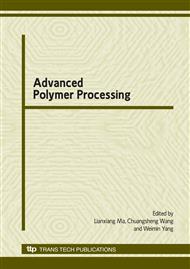[1]
P. P. Klemchuk. Degradable plastics: a critical review, Polymer Degradation and Stability. Vol. 27(1990), p.183.
DOI: 10.1016/0141-3910(90)90108-j
Google Scholar
[2]
A. A. S. Curvelo, A. J. F. Carvalho, & J. A. M. Agnelli. Thermoplastic starch- cellulosic fibers composites: preliminary results. Carbohydrate Polymer, Vol. 45(2001), p.183.
DOI: 10.1016/s0144-8617(00)00314-3
Google Scholar
[3]
A. S. Herrmann, J. Nickel, & U. Riedel. Construction materials based upon biologically renewable resources-from components to finished parts. Polymer Degradation and Stability, Vol. 59(1998), p.251.
DOI: 10.1016/s0141-3910(97)00169-9
Google Scholar
[4]
P. M. Forssell, J. M. Mikkila¨, & G. K. Moates. Phase and glass transition behaviour of concentrated barley starch-glycerol-water mixtures: a model for thermoplastic starch. Carbohydrate Polymers, Vol. 34(1997), p.275.
DOI: 10.1016/s0144-8617(97)00133-1
Google Scholar
[5]
S. H. D. Hulleman, F. H. P. Janssen, & H. Feil. The role of water during plasticization of native starches. Polymer, Vol. 39 (1998), p. (2043).
DOI: 10.1016/s0032-3861(97)00301-7
Google Scholar
[6]
L. Averous, N. Fauconnier, & L. Moro. Blends of thermoplastic starch and polyester-amide: processing and properties. Journal of Applied Polymer Science, Vol. 76(2000).
DOI: 10.1002/(sici)1097-4628(20000516)76:7<1117::aid-app16>3.0.co;2-w
Google Scholar
[7]
D. Demirgöz, C. Elvira, & J. F. Mano. Chemical modification of starch based biodegradable polymeric blends: effects on water uptake, degradation behaviour and mechanical properties. Polymer Degradation and Stability, Vol. 70(2000), p.161.
DOI: 10.1016/s0141-3910(00)00102-6
Google Scholar
[8]
A. Dufresne, & M. R. Vignon. Improvement of starch film performance using cellulose microfibers. Macromolecules, Vol. 31 (1998), p.2693.
DOI: 10.1021/ma971532b
Google Scholar
[9]
M. Wollerdorfer, & H. Bader. Influence of natural fibres on the mechanical properties of biodegradable polymers. Industrial Crops and Products, Vol. 8(1998), p.105.
DOI: 10.1016/s0926-6690(97)10015-2
Google Scholar
[10]
U. Funke, W. Bergthaller, & M. G. Lindhauer. Processing and characterization of biodegradable products based on starch. Polymer Degradation and Stability, Vol. 59(1998), p.293.
DOI: 10.1016/s0141-3910(97)00163-8
Google Scholar
[11]
A. Dufresne, D. Dupeyre, & M. R. Vignon. Cellulose microfibrils from potato tuber cells: Processing and characterization of starchcellulose microfibril composites. Journal of Applied Polymer Science, Vol. 76(2000), p. (2080).
DOI: 10.1002/(sici)1097-4628(20000628)76:14<2080::aid-app12>3.0.co;2-u
Google Scholar
[12]
X.F. Ma, J.G. Yu, J.F. Kennedy. Studies on the properties of natural fibers reinforced thermoplastic starch composites. Carbohydrate Polymers, Vol. 62(2005), p.19.
DOI: 10.1016/j.carbpol.2005.07.015
Google Scholar
[13]
J.Y. Pang, X.Z. Mo, & Y. Liang. Modification of banana fiber and properties of epoxy composites, Technology & Development of Chemical Industry, Vol. 37(2008), p.6.
Google Scholar
[14]
K. Vijay, & H. K. Sanjeev. Effect of compressional force on the crystallinity of directly compressible cellulose excipients. International Journal of Pharmaceutics, Vol. 177(1999), p.173.
DOI: 10.1016/s0378-5173(98)00340-8
Google Scholar
[15]
A. Amash, & P. Zugenmaier. Morphology and properties of isotropic and oriented samples of cellulose fibre-polypropylene composites. Polymer, Vol. 41(2000), p.1589.
DOI: 10.1016/s0032-3861(99)00273-6
Google Scholar


